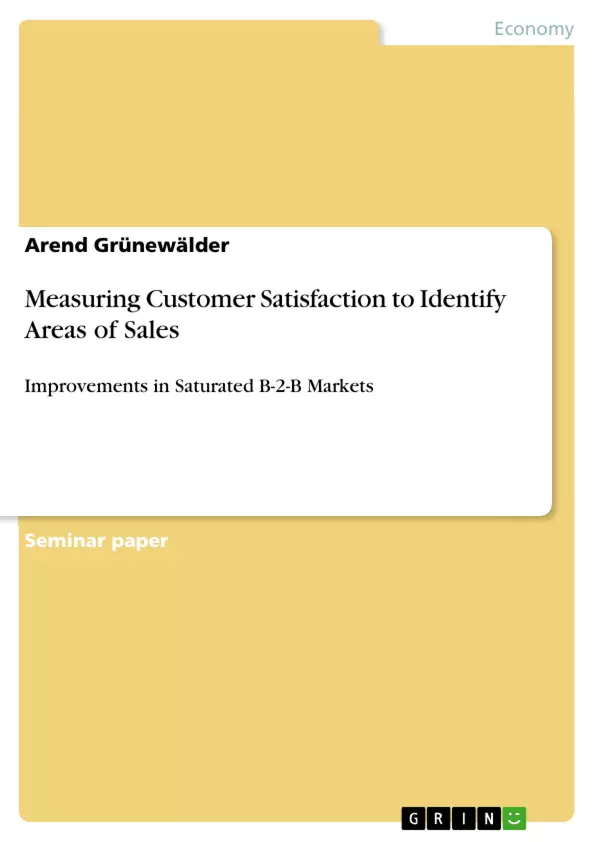This work is about measuring customer satisfaction with the focus on B-2-B markets. In the first chapters the determinants are explained along with the problem of a not well designed measuring program. The intention of this work is to analyze and describe a thoroughly conducted research on satisfaction of industrial customers. The main chapter is organised according the chronological steps for a common research in that field. Each chapter or research element illustrates a correlation to the specific situation of suppliers in B-2-B markets. Basically, this work suggests planning a survey on customer satisfaction in two major steps: firstly, to explore the expectations and attitudes in a qualitative research, and then, based on the first step, to interview customers on their perceptions concerning how well the firm is meeting those expectations. Before drawing the conclusion of this work, the importance of customer satisfaction for companies competing in saturated markets is investigated.
Inhaltsverzeichnis (Table of Contents)
- Executive Summary
- Table of Contents
- List of abbreviations
- List of figures
- 1. Introduction
- 1.1 Customer Satisfaction
- 1.2 Business Markets
- 1.3 The Advantages of Satisfying Customers
- 1.4 Risk of a Poorly Conceived Survey
- 2. Tailoring a Successful Survey
- 2.1 Exploratory Research
- 2.2 Sampling
- 2.2.1 Survey Objectives
- 2.2.2 Sampling Frame and Segmentation
- 2.2.3 Method of Collecting Data
- 2.2.4 Design of the Questionnaire
- 2.3 Analysing and Reporting
- 3. Importance of Customer Satisfaction in Saturated Markets
- 4. Conclusion
- Appendix
- Bibliography
- ITM Checklist - 360° Analysis
Zielsetzung und Themenschwerpunkte (Objectives and Key Themes)
This work aims to analyze and describe the importance of measuring customer satisfaction in B-2-B markets, focusing on the practical application of research methodologies. The main objective is to present a comprehensive guide for conducting successful customer satisfaction surveys in this specific industry.- The determinants of customer satisfaction in B-2-B markets
- The process of designing and conducting a customer satisfaction survey
- The importance of customer satisfaction in saturated B-2-B markets
- The risks associated with poorly designed surveys
- The correlation between research elements and the specific situation of suppliers in B-2-B markets
Zusammenfassung der Kapitel (Chapter Summaries)
The first chapter provides a general introduction to customer satisfaction, focusing on the importance of understanding customer needs and expectations in B-2-B markets. It discusses the benefits of satisfying customers and explores the risks of conducting poorly designed surveys. The chapter also touches upon the concept of the Decision Making Unit (DMU) in B-2-B contexts. The second chapter delves into the practical aspects of conducting a successful customer satisfaction survey. It focuses on the different stages of the research process, including exploratory research, sampling methodologies, data collection techniques, and questionnaire design. The chapter emphasizes the importance of tailoring the survey to the specific needs of the company and the industry. The third chapter investigates the critical role of customer satisfaction in saturated markets. It examines how companies can differentiate themselves from competitors by focusing on meeting and exceeding customer expectations. The chapter highlights the importance of building strong customer relationships and understanding their needs in a competitive landscape.Schlüsselwörter (Keywords)
This work focuses on the key topics of customer satisfaction, B-2-B markets, market research methodologies, survey design, data analysis, and customer relationship management. Other significant concepts include the importance of understanding customer expectations, identifying key influencers, and conducting successful customer satisfaction surveys to drive business improvements in a competitive environment.- Citar trabajo
- Arend Grünewälder (Autor), 2008, Measuring Customer Satisfaction to Identify Areas of Sales, Múnich, GRIN Verlag, https://www.grin.com/document/115448



